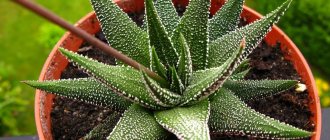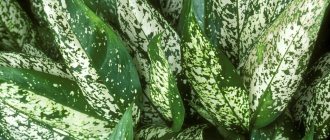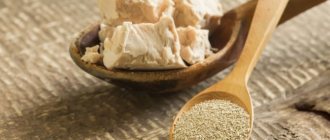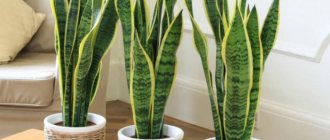FacebookTwitterPinterestEmailWhatsAppVKontakte
Aloe vera is a succulent plant that includes a large number of vitamins (A, group B, C, E), minerals (iron, potassium, calcium, magnesium), organic acids (succinic, citric, etc.). Everyone knows exactly what it looks like, what it tastes and smells like. Such a plant rarely blooms and survives the long absence of the owners of the house, because it has a good smell of moisture for several years to come.
Moreover, aloe juice is useful for both external and internal use. However, along with this, it has a number of contraindications and can cause harm to the body if used incorrectly. That is why it is so important to carefully study its properties and know its “composition”. For example, enzymes help break down sugar and fats, and the hormones auxins and gibberellins promote rapid wound healing and have an anti-inflammatory effect.
The list of benefits of using and using aloe does not end there. Here are its main studied properties:
- Has a general strengthening effect, improves immunity;
- Normalizes digestion;
- Eliminates diarrhea and constipation;
- Rejuvenates the skin, relieves tightness;
- Heals wounds, relieves pain from burns, moisturizes and disinfects the skin;
- Improves vision;
- Treats headaches;
- Copes with colds.
Aloe juice is successfully used to prepare immunostimulating agents, as well as as part of drugs against cancer. Many people use it in folk medicine, without the recommendation of doctors, as they consider it safe and universal.
Along with this, the plant also has harmful components that can cause side effects and allergic reactions, which will be discussed below.
How to make juice at home
It is worth noting that the juice obtained from the cold-aged plant is much healthier and has a higher concentration of useful substances than aloe juice without pre-cooling. For this reason, it is better to adhere to the well-known juice preparation technology:
- Cut off the lower “leaves” of the aloe and put them in a dark, cool place.
- Rinse.
- Grind in a blender or with a knife;
- Add cold boiled or distilled water to the resulting mixture in a ratio of 1:3, mix and place in the refrigerator again for 2-3 hours.
- Take out the container, transfer the “gruel” to cheesecloth or a sieve and strain thoroughly. Pour the juice into a glass container with a lid and place in the refrigerator.
Features of the plant leaf
Aloe leaves have an unusual structure and include a gelatinous, gel-like core surrounded by a layer of sap and a thin, tough skin. Leaves can accumulate large amounts of water, increasing significantly in size. To preserve moisture, the leaves close their pores, which prevents the evaporation of water when there is insufficient supply from the outside. During prolonged drought, the size of the leaves visually decreases due to the consumption of moisture reserves. Also, in unfavorable conditions, the plant sheds its lower leaves in order to preserve life.
How to make medicine from aloe vera with honey
Aloe with honey is a popular combination that is used in folk medicine for the prevention and treatment of diseases, and the elimination of cosmetic problems.
You can prepare various drinks, masks, mixtures, and infusions from aloe and honey.
The two components enhance each other’s healing properties, help fight bacteria, viruses, fungi, relieve inflammation, relieve pain, and stimulate cell and tissue regeneration.
Recipe number 1 (for cough)
Mix aloe juice and honey in a 1:1 ratio and take 1 tablespoon orally before meals 3 times a day.
Recipe number 2 (for gastrointestinal tract)
Grind aloe stems and combine with honey in a 2:1 ratio. Take one teaspoon 2 times a day with water. Course duration is 21 days.
aloe and honey
Recipe number 3 (general strengthening)
To boost immunity, chop 1 cup of walnuts, add 200 milliliters of aloe extract, 100 grams of honey, one teaspoon of lemon juice. Take one spoon before meals three times a day for two weeks.
"Home Doctor"
The aloe plant is famous for its healing properties, although its name means “bitter” in Arabic. Among the main properties are antimicrobial and anti-inflammatory. Not every plant is suitable - aloe must be at least 3 years old.
The most valuable element is the pulp. In addition to water (96%), it contains minerals and vitamins. The main medicinal substance is acemannan, which can help in the prevention of viral infections.
Fresh juice is good for healing wounds that take a long time to heal. It also helps get rid of a persistent runny nose. Moreover, the juice is best extracted from aloe vera, preferably in the cold season (do not water for 2 weeks before cutting).
It is also useful for throat diseases, as well as for problems with gums. And if calluses or corns appear, the cut leaves are applied to the sore spot.
The restorative and rejuvenating effect is another feature of aloe. That is why the leaves are used to make masks, creams and balms.
Treatment with aloe juice
It’s worth saying right away that aloe juice should not be stored for future use, as it spoils very quickly. It must be stored in a closed glass container in the refrigerator for no more than 12 hours.
Aloe juice is a yellowish liquid, latex, which is a kind of plant protection from animals. It has a bitter taste and a large number of healing properties.
It is well used as a laxative that increases the amount of fluid in the body and stimulates mucus secretion.
Important! If you consume 20-30 ml of aloe juice daily, it will help reduce flatulence and relieve irritable bowel syndrome.
You can obtain juice using a juicer, or by chopping the stems and squeezing the liquid out of them by hand.
Aloe for the face at home
Very often the plant is used for cosmetic purposes, as it has pronounced anti-inflammatory, regenerating, and rejuvenating properties.
Prepared masks and mixtures can be applied to any type of facial skin at any time of the year. Even dermatologists recommend using folk remedies containing aloe to treat burns, eliminate stretch marks, and acne.
Wrinkles
To reduce the number of small expression wrinkles, apply the crushed plant to the skin of the face for 10-15 minutes 2-3 times a week. Thanks to the content of 20 of the 22 amino acids necessary for human skin in aloe, the product will do an excellent job of moisturizing, nourishing, rejuvenating and softening.
Acne
For effective acne treatment, it is necessary to soak gauze or thin soft cloth with aloe juice and apply to the face for 40-60 minutes. After the procedure, you should not wash off the remaining juice from your face for another 2-3 hours. Enzymes will act on the upper layers of the epidermis throughout the entire time, clearing away pollution, preventing the development of microinfections and inflammation.
Mannose, which is part of the juice, has antibacterial properties, which also help reduce the number of rashes on problem skin.
Using aloe juice for hair
Any mask to which you add aloe juice is not recommended to be applied to the hair roots, but only distributed along the length.
If the composition contains any irritating “component”, then it is better to leave the mask on the hair until washed. If all ingredients are mild, they can be used on clean hair immediately after washing.
When making a hair mask, decide what result you want to see: achieve an antibacterial effect, improve the appearance or treat your hair.
Each one uses only juice (latex). Homemade, made independently, is more effective than pharmacy.
Recipe 1. For dry hair (damaged by a hair dryer or bio-perm)
Mix aloe juice with kefir, sour cream or cream, apply to hair and rinse after 10 minutes.
Recipe 2. Remove fat content
If you combine aloe juice with blue, green or black clay, cognac or lemon and leave the mask for 10-15 minutes, you can normalize the production of sebum on your head, while simultaneously “nourishing” it with useful microelements and amino acids.
Recipe 3. If you need to improve hair growth
An excellent stimulating mask of aloe and honey. For 2 teaspoons of honey, take 1 teaspoon of juice, mix and apply to hair. Leave the mask on for 30-40 minutes, wrapping your hair in a towel or a special “cap”.
The mask awakens hair follicles to growth and helps speed up the process of “growing” beautiful and healthy hair.
Dosage forms of aloe vera in pharmacology
Aloe is produced as independent preparations in liquid and dry extract, and as part of many other medicines.
- Liquid extract. This drug is a biogenic stimulant and is intended for subcutaneous injection. Used in gastroenterology, neurology, pulmonology. Injections are prescribed for gastritis, colitis, cholecystitis. They provide a therapeutic effect for neuralgia, neuritis, pneumonia, bronchitis, tuberculosis, and after a stroke. Injections are recommended in the complex treatment of male infertility, various ophthalmological diseases - conjunctivitis, blepharitis, keratitis and other inflammations. The drug is effective in reducing visual acuity, hearing and smell. Read more about aloe injections in our other article.
- Juice. Used internally, externally, locally. The juice preservative is alcohol. Belongs to the group of laxatives, tonics, immunomodulatory, bactericidal drugs. The juice enhances the effect of other laxatives, as well as drugs that stimulate hematopoiesis. There may be a risk of potassium deficiency if aloe juice is used concomitantly with diuretics (diuretics).
- Aloe liniment. It is a creamy mass. It is used externally for burns (including radiation), dermatitis, neurodermatitis, psoriasis, eczema, lichen ruber, atrophic lesions of the mucous membrane and skin of the vulva. Apply a thin layer to the affected areas several times a day, covering with gauze. For severe lesions, apply a thick layer without a bandage.
- Syrup with iron. This combined herbal preparation is prescribed for hypochromic anemia; it replenishes iron deficiency and increases hemoglobin levels. The drug can also be used as an antiseptic, laxative, choleretic, adaptogenic and tonic. The syrup has a fairly extensive list of contraindications: chronic renal failure, heart failure, cholelithiasis, cystitis, high blood pressure, hemorrhoids, uterine bleeding, and other types of anemia.
- Pills. Prescribed for progressive myopia, to accelerate tissue regeneration. Drink for a long time - at least a month. If prescribed by a doctor, you can take a second course after 3–6 months. There are film-coated tablets, 20 pieces per package. Another drug is also offered on the pharmacological market - aloe in the form of a dietary supplement (240 pieces in a jar). This drug contains cellulose, lactose, vitamin C, B vitamins, calcium, nicotinamide (vitamin PP).
You can also purchase skin care cosmetics with aloe extract in pharmacies and specialized stores - hand and face creams, lotions, peeling masks, gels, deodorants.
Aloe in folk medicine is a proven and effective remedy. For many decades, recipes for preparing tinctures, ointments, and decoctions from the juice of this flower have been collected. They are used in the complex treatment of constipation, gastritis, pancreatitis, sore throat, laryngitis, sinusitis, bronchitis, pneumonia, anemia and many other diseases. No less valuable is the external use of agave.
Source
Natural shampoo for hair growth
Homemade shampoo, which includes a component such as aloe, perfectly helps nourish dry and brittle hair, restores lightness, gives shine and a healthy appearance.
They can be used either in addition to regular shampoo or independently, every day.
Shampoo "Coconut"
Mix 100 ml of aloe juice and 50 ml of coconut oil, add the resulting mixture to your regular shampoo and use as directed. The lauric and miramistic acids included in the composition will help restore the protective properties of the scalp and “overcome” pathogenic microorganisms.
Nourishing shampoo for hair volume
Another way to give your hair a clean, healthy look and add volume at the roots is to make a natural shampoo with aloe and baking soda.
To do this, take 100 grams of dried crushed aloe leaves, mix with the same amount of water and add 4 tablespoons of baking soda. This option does not require mixing with regular shampoo and can be applied to hair without any additives or add-ons.
Aloe is an excellent dermatological remedy for skin diseases
Aloe has long been used as a bactericidal and bacteriostatic agent in the treatment of wounds, burns, ulcers, mastitis, abscesses, etc.
At the same time, the juice can be used superficially not only for serious injuries or cuts, but also for insect bites, lichen, psoriasis, and herpes.
To heal yourself at home and relieve itching and pain, it is enough to lubricate wounds and burns with aloe juice or make short-term lotions.
When treating and preventing psoriasis, it is necessary to add tincture of celandine and calamus root to the juice in equal proportions. Pour all this over 1 cup of boiling water and let it brew for 2-3 hours.
For severe burns, apply cotton wool or a bandage soaked in aloe juice to the wound, changing the bandage every 5-10 minutes for the first hour.
Aloe and Herpes: Treats or Relieves Itching
The home plant and its juice cope well with the herpes virus, helping to cleanse ulcers and purulent wounds, as well as produce antibodies.
To do this, apply a damp bandage to the affected area for 10-15 minutes every hour. During an exacerbation, it is necessary, in parallel with cosmetic treatment, to take aloe juice orally to strengthen the immune system - 1 teaspoon 3 times a day.
If there is no juice, you can apply crushed aloe, carefully spreading it on a gauze bandage or cotton wool.
Contraindications
- Acute disorders of digestive function;
- Hypersensitivity to aloe;
- Hypertension;
- Severe cardiovascular diseases;
- Chronic diseases in the acute stage;
- Hemorrhoidal and uterine bleeding, menstruation (especially laxatives from the plant);
- Pregnancy (internal use);
- Children under 3 years of age. Externally - it is possible from a year, but 2 times less concentration.
Aloe for the intestines and digestion
Aloe juice is a good laxative and therefore ideal for those who have intestinal problems, suffer from flatulence, constipation, and complain of irritable bowel syndrome.
For gastritis, you can safely dilute 1 tablespoon of home flower gel in a glass of water and take it no more than 2 times a day.
Along with this, do not forget that if you have gastritis, you should drink as much fluid as possible, not only aloe, but also plain water.
The plant has a beneficial effect on the gastrointestinal tract because:
- Accelerates the production of bile.
- Relieves inflammatory processes.
- Increases the secretion of digestive glands.
- Removes toxins.
- Renews blood.
Important! The high content of useful components (amino acids, enzymes, ascorbic acid, B vitamins, phenolic substances) helps in the treatment of intestinal and digestive diseases, improves the absorption of nutrients.
Benefits of plant leaves
The benefits of aloe are easy to explain if you know the composition of the pulp of its leaves.
The plant contains about 200 biologically active substances, each of which has certain benefits.
Aloe contains:
- vitamins A, E, C;
- B vitamins;
- amino acids;
- polysaccharides;
- anthraquinone glycosides;
- resins;
- phytoncides;
- gelonins;
- enzymes, etc.
Aloe is known for its wound healing properties . In addition, the juice of the plant accelerates the process of restoration of the mucous membrane of the stomach and duodenum. Aloe also has anti-burn, analgesic, anti-inflammatory and antimicrobial properties. It has a detrimental effect on:
- fungi;
- staphylococci;
- streptococci;
- causative agents of dysentery and diphtheria.
In small doses, aloe juice improves appetite and digestion, in large doses it acts as a laxative. Indications for the use of plant juice are also colds, diseases of the mucous membranes, stomatitis and even tuberculosis.
We discuss the beneficial and medicinal properties of aloe in more detail in a separate material.
Pharmaceutical product
Pharmacy aloe is often confused with agave, which is grown at home. The difference between these plants is small, but still there. Agave is a type of pharmaceutical aloe (aloe vera). The main difference between these plants is their appearance. Aloe vera has long, pointed leaves that grow from the root upward. Agave grows in the form of a small tree with a trunk on which pointed leaves are located.
The leaves of indoor agave are much thinner and smaller than those of pharmaceutical aloe, so they contain little useful juice. But both agave and pharmaceutical aloe have almost the same beneficial properties.
For oral administration, it is aloe vera that is used, not agave.
Want to strengthen your immune system: choose aloe
Anyone who cares about their health strives to improve their immunity.
The enzymes contained in aloe juice help stimulate the immune system and completely destroy existing infections, viruses, and bacteria.
To prepare a powerful and effective remedy for strengthening the body, mix 30 grams of aloe leaves and 60 grams of lemon peel and chop. Add 3 tablespoons of honey, mix and leave in a cool place for 12 hours.
It is recommended to use 2-3 times a day before meals, 1 teaspoon.
Single plant: proper placement
The difference between aloe is its powerful vertical root system, so it will require a deep pot. It is advisable that there are no other plants nearby. Aloe is a loner and does not like “neighbors”.
The seeds or shoot are planted in fertile, loose soil. Not only looseness, but also permeability of the soil is important. It’s easier to purchase a prepared substrate, but you can make a suitable mixture yourself. For 2 parts of sod-clay soil - 1 part of leaf and sand. For drainage - a little expanded clay, peat and charcoal.
Maximum favorable conditions:
- plenty of sunlight, preferably south facing;
- in winter it needs to be illuminated;
- in summer, move to the balcony, but protect from precipitation;
- Room temperature is suitable, but in winter – up to +14.
The plant tolerates transplantation well, but it should not be frequent. It is advisable to resort to it when the flower becomes frankly cramped in the pot. It is preferable to replant bushes at the beginning of the growing season. Young plants - once every 2-3 years, adults - once every 4 years.
When is aloe effective: for diabetes or obesity
Due to the fact that the plant helps reduce cholesterol and blood sugar levels, it is excellent for weight loss and lowers blood glucose.
By regularly taking decoctions, infusions or aloe juice, you can gain health, increase immunity, get rid of excess weight and normalize the functioning of the nervous system.
Recipe
Cool the stems, chop them, pour vodka in a ratio of 1:5. After a month, the infusion can already be taken 1 teaspoon 2 times a day 15-20 minutes before meals.
The benefits and harms of home flowers
Agave has many beneficial properties. The leaves and juice of the plant are used for medicinal purposes. The juice and pulp of a three-year-old plant, which is collected in late autumn, is considered the most effective.
With the help of a flower they treat:
- constipation, including chronic constipation;
- infectious skin diseases, furunculosis;
- festering wounds;
- streptococcal and staphylococcal infections;
- intestinal, typhoid, dysentery bacillus;
- anemia;
- metabolic problems;
- burns and some skin diseases;
- various forms of neuroses;
- bronchial asthma;
- chronic gastritis and stomach ulcers;
- eye diseases.
However, you should not overuse aloe. This is especially true for the internal use of flower-based products. With long-term use of drugs based on agave, potassium is washed out, which leads to metabolic disorders. Women during pregnancy should not take aloe due to the risk of miscarriage.
Internal use of aloe is contraindicated for people suffering from diabetes, since the plant tends to lower blood sugar levels. In combination with insulin, the patient may develop hypoglycemia. Preparations based on the plant are contraindicated for people with liver diseases, gall bladder, as well as cystitis and hemorrhoids.
How to prepare correctly
Aloe juice or crushed stems are stored in a cool, dark place for no more than 2 days. For this reason, it makes no sense to procure large quantities for future use. However, to make daily use easier, you can refrigerate the plant stems in advance and immediately chop them before use.
Before you are ready to break off the leaves, do not water the flower for 7 days. It is better to “remove” the stems themselves at the very bottom, where they are thicker and larger.
If you need dried “leaves,” cut them into pieces, place them on paper or a napkin, and leave them until completely dry. When the aloe takes on a wrinkled appearance, becomes brittle and fragile, it can be transferred to rag bags or paper packaging. Dried aloe stems can be stored for up to two years.
Short description
As a member of the Xanthorrhoeaceae family, the aloe plant is a succulent native primarily to Africa and the Arabian Peninsula.
Of the more than 500 varieties of this family, the most commonly cultivated and used is Aloe Vera, a native of the Mediterranean and aloe vera arborescens, commonly referred to as agave.
A characteristic feature is the fleshy leaves of various shades of green, shaped like a sword with spikes along the edges. The roots are superficial, fibrous.
Features of the workpiece
At home, the leaves that are to be harvested are located at the bottom and in the middle part of the stem. The plant must be at least five years old. It was by this time that the beneficial properties of aloe, which made it popular in folk medicine and cosmetology, fully manifest themselves.
Leaves should not be broken off or cut off. They are removed at any time along with the sheaths, which are easily separated from the stem. Before preparing aloe with your own hands in a certain dosage form, you should keep the leaf for 10 - 12 days in the refrigerator. This is due to the fact that at low temperatures, unique biostimulants are produced and accumulated to support the slowing process of life.
If you need to preserve the raw materials longer, then the washed leaves are cut and laid out on white sheets of paper in a ventilated warehouse, balcony or under a canopy, where the burning rays of the sun do not reach. They can be stored in a dry state for up to two years in bags made of thick fabric or paper.
Recommended Dosages
In order not to harm your health or your skin, you should adhere to certain dosages and duration of the course of using the tincture, gel or juice.
- For gastrointestinal disorders, no more than 300 ml per day is permissible.
- For plaque or bleeding gums, add 1 teaspoon of gel or juice to the toothpaste.
- For burns, 100% aloe gel can be applied an unlimited number of times.
To reduce acne and improve the condition of facial skin, add 3 drops of aloe juice to a cotton pad soaked in lotion.
Possible side effects
When using any folk remedy or drug, allergic reactions and side effects may occur.
For example, consumption can cause individual intolerance to its components, heartburn, diarrhea, increased menstrual flow, and increased uterine tone.
Important! When aloe is used simultaneously with other medications, the active effect of the latter may decrease.
Not recommended for pregnant and lactating women.
Some interesting facts
- Aloe is an amazing healing plant that can go without water for up to 7 years, since it can accumulate moisture and retain it in the stems for a long time.
- In the Middle East, they believe not only in the healing power of the plant, but also in the “otherworldly”, which helps protect the house and home from evil people and spirits. To do this, hang the dried stem above the front door.
- Agave juice can even be added to regular tea; it helps improve appetite, lift your mood, and strengthen your immune system.
- In the food industry, whole pieces of aloe are added to yoghurts, lemonades, and cocktails.
- If consumed incorrectly or in excess, pure juice can cause poisoning.
- This type of plant and its healing properties were discovered more than 4000 years ago.
- A very popular indoor flower that grows in almost every family.
- If you put the stem in water, air bubbles will form around it.
- The older the leaves, the thicker they are and the stiffer and rougher their spines. This is because older stems accumulate more moisture.
- There is an interesting belief that if flowers appear on an aloe, then the owner of the house will be happy for the same number of years as there are flowers on the plant.
Aloe is an amazing and healing flower that helps not only to improve the house, but also to cure during periods of illness, boost immunity, maintain health and give vitality. For its successful growth, it is enough just to plant it in a spacious bowl, put it in a bright place, and not water it too often.
Such care is the key to rapid growth and proliferation of the flower. It can be easily seated and given to your friends and relatives.
FacebookTwitterPinterestEmailWhatsAppVKontakte
Plant propagation and flowering
Autumn is ideal for breeding. If side shoots are used, they should not be placed in water immediately. You need to wait a few days for the seedlings to “ventilate”.
If a plant has formed two trunks (usually a tree-like species), the roots should be carefully separated. Then plant the plants in separate pots.
In order for the “pet” to please with flowers, a period of rest is required. Such conditions can be ensured only with long daylight hours and coolness. This is difficult to do in an apartment, which is why flowering is rare.











